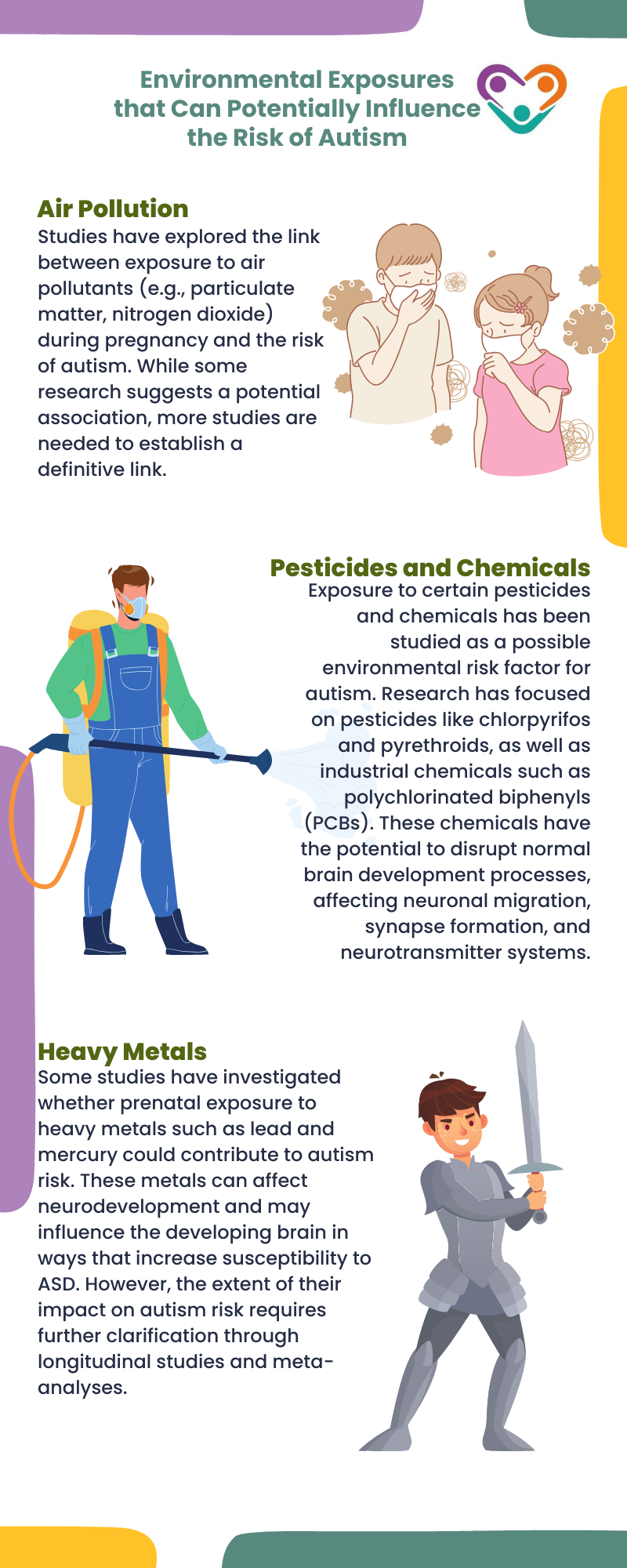Autism spectrum disorder (ASD) is a complex neurodevelopmental condition characterized by challenges in social interaction, communication, and repetitive behaviors. While the exact causes of autism remain a subject of ongoing research, scientists believe that both genetic and environmental factors play significant roles in its development.
In recent years, there has been increasing interest in understanding how environmental factors may contribute to the risk of autism.

Understanding Autism Spectrum Disorder
Before delving into environmental factors, it’s crucial to grasp the basics of autism spectrum disorder.
ASD encompasses a wide range of conditions that vary in severity and symptoms. Individuals with ASD may experience difficulties in social communication, such as understanding nonverbal cues or maintaining conversations. They may also exhibit repetitive behaviors or have highly focused interests.
The spectrum nature of ASD means that each person’s experience with the disorder is unique, influenced by a combination of genetic predispositions and environmental exposures.
Genetic and Environmental Factors and Their Influence
Genetic research has highlighted that ASD has a strong genetic component. Studies have shown that certain gene mutations or variations can increase the likelihood of developing autism. These genetic factors can influence brain development and how individuals process information.
For example, mutations in genes involved in synaptic function or neuronal connectivity have been implicated in ASD. Understanding these genetic underpinnings provides important insights into the biological mechanisms that contribute to autism.
Beyond genetics, environmental factors have garnered attention as potential contributors to the development of autism. Environmental factors refer to external influences that individuals may encounter before birth, during infancy, or throughout childhood.
These factors can range from prenatal exposures to early childhood experiences. The interaction between genetic susceptibility and environmental exposures is complex and not yet fully understood, but researchers continue to investigate how these factors may interact to increase autism risk.

Prenatal and Perinatal Influences
Research suggests that events occurring during pregnancy and around the time of birth may impact autism risk.
Factors such as maternal infections, exposure to certain medications (e.g., valproic acid), and complications during birth have been studied. Maternal health conditions like diabetes and obesity are also being investigated for their potential association with autism.
The prenatal period is critical for brain development, and disruptions during this time may contribute to neurodevelopmental disorders like ASD.
Environmental Exposures
Several environmental exposures have been hypothesized to influence autism risk, although the evidence remains mixed and requires further investigation. These include:

Nutritional Factors
Nutritional factors during pregnancy and early childhood have also been explored. Research suggests that maternal folic acid intake and prenatal nutrition could play a role in reducing the risk of autism.
Additionally, deficiencies in certain vitamins and minerals (e.g., vitamin D) have been studied for their potential impact on neurodevelopment. Adequate nutrition during critical periods of brain development is essential for optimizing neuronal growth and function, potentially influencing the risk of neurodevelopmental disorders like ASD.
Parental Age and Other Factors
Advanced parental age, particularly in fathers, has been associated with a slightly increased risk of autism in offspring. This relationship is thought to involve genetic mutations that accumulate in sperm over time.
Other factors under investigation include maternal stress during pregnancy, maternal immune responses, and the influence of the microbiome (gut bacteria) on brain development.
These factors highlight the complex interplay between genetic predispositions and environmental influences in shaping autism risk.
The Complexity of Research Findings
It’s important to note that while numerous environmental factors have been studied, many findings are preliminary or inconclusive. Autism is a complex disorder with varied presentations, and individual experiences can differ widely.
Researchers continue to explore how combinations of genetic predispositions and environmental influences interact to shape autism risk. Longitudinal studies that follow individuals from prenatal development through childhood and adolescence are crucial for understanding the cumulative effects of environmental exposures on neurodevelopment.
While genetic factors significantly contribute to autism spectrum disorder, environmental factors also play a role in shaping individual risk. Understanding these environmental influences is crucial for developing strategies to support early intervention and improve outcomes for individuals with ASD.
Ongoing research is essential to clarify the complex interactions between genetics, environment, and neurodevelopment in the context of ASD. As research advances, the hope is to understand better how to mitigate environmental risks and enhance support systems for individuals and families affected by autism spectrum disorder.
Sources:
https://www.thetransmitter.org/spectrum/environmental-risk-autism-explained
https://www.ncbi.nlm.nih.gov/pmc/articles/PMC5377970
https://sparkforautism.org/discover_article/environment-autism



